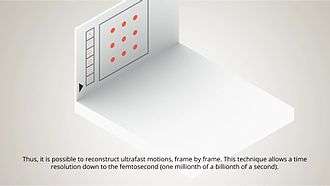Time resolved crystallography

Time resolved crystallography utilizes X-ray crystallography imaging to visualize reactions in four dimensions (x, y, z and time). This enables the studies of dynamical changes that occur in for example enzymes during their catalysis. The time dimension is incorporated by triggering the reaction of interest in the crystal prior to X-ray exposure, and then collecting the diffraction patterns at different time delays. In order to study these dynamical properties of macromolecules three criteria must be met;[1]
- The macromolecule must be biologically active in the crystalline state
- It must be possible to trigger the reaction in the crystal
- The intermediate of interest must be detectable, i.e. it must have a reasonable amount of concentration in the crystal (preferably over 25%).
This has led to the development of several techniques that can be divided into two groups, the pump-probe method and diffusion-trapping methods.
Pump-probe
In the pump-probe method the reaction is first triggered (pump) by photolysis (most often laser light) and then a diffraction pattern is collected by an X-ray pulse (probe) at a specific time delay. This makes it possible to obtain many images at different time delays after reaction triggering, and thereby building up a chronological series of images describing the events during reaction. To obtain a reasonable signal to noise ratio this pump-probe cycle has to be performed many times for each spatial rotation of the crystal, and many times for the same time delay. Therefore the reaction that one wishes to study with pump-probe must be able to relax back to its original conformation after triggering, enabling many measurements on the same sample.
Diffusion-trapping
Diffusion-trapping methods utilizes diffusion techniques to get the substrates into the crystal and thereafter different trapping techniques are applied to get the intermediate of interest to accumulate in the crystal prior to collection of the diffraction pattern. These trapping methods could involve changes in pH,[2] use of inhibitor[3] or lowering the temperature in order to slow down the turnover rate or maybe even stop the reaction completely at a specific step. Just starting the reaction and then flash-freeze it,[4] thereby quenching it at a specific time step, is also a possible method. One drawback with diffusion-trapping methods is that they can only be used to study intermediates that can be trapped, thereby limiting the time resolution one can obtain through the methods as compared to the pump-probe method.
See also
References
- ↑ Hajdu, J; Neutze, R; Sjögren, T; Edman, K; Szöke, A; Wilmouth, RC; Wilmot, CM (2000). "Analyzing protein functions in four dimensions". Nature Structural Biology. 7 (11): 1006–12. doi:10.1038/80911. PMID 11062553.
- ↑ Yamashita, Atsuko; Endo, Masaharu; Higashi, Tsuneyuki; Nakatsu, Toru; Yamada, Yasuyuki; Oda, Jun'Ichi; Kato, Hiroaki (2003). "Capturing Enzyme Structure Prior to Reaction Initiation: Tropinone Reductase-II−Substrate Complexes‡". Biochemistry. 42 (19): 5566–73. doi:10.1021/bi0272712. PMID 12741812.
- ↑ Miller, MT; Bachmann, BO; Townsend, CA; Rosenzweig, AC (2002). "The catalytic cycle of β-lactam synthetase observed by x-ray crystallographic snapshots". Proceedings of the National Academy of Sciences of the United States of America. 99 (23): 14752–7. doi:10.1073/pnas.232361199. PMC 137491
 . PMID 12409610.
. PMID 12409610. - ↑ Fiedler, E.; Thorell, S; Sandalova, T; Golbik, R; König, S; Schneider, G (2002). "Snapshot of a key intermediate in enzymatic thiamin catalysis: Crystal structure of the α-carbanion of (α,β-dihydroxyethyl)-thiamin diphosphate in the active site of transketolase from Saccharomyces cerevisiae". Proceedings of the National Academy of Sciences. 99 (2): 591–5. doi:10.1073/pnas.022510999. PMC 117350
 . PMID 11773632.
. PMID 11773632.